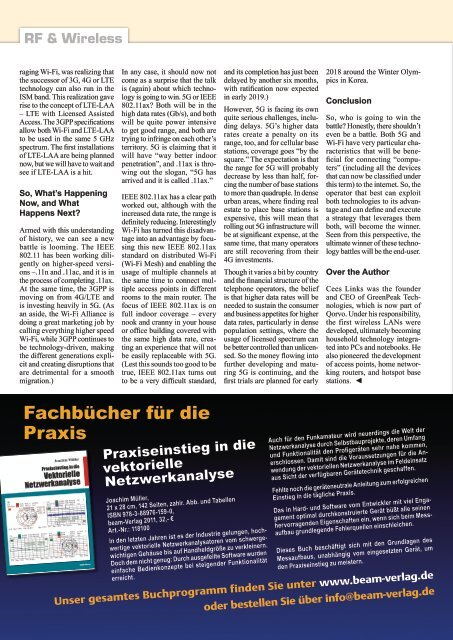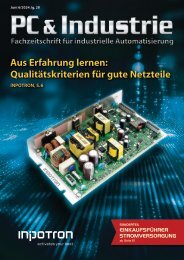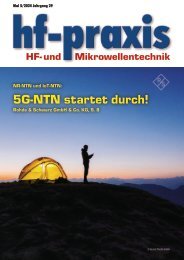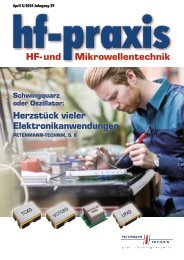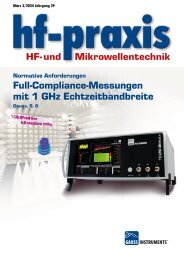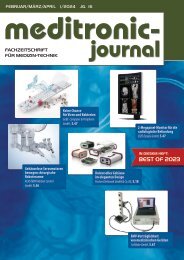10-2018
Fachzeitschrift für Hochfrequenz- und Mikrowellentechnik
Fachzeitschrift für Hochfrequenz- und Mikrowellentechnik
Erfolgreiche ePaper selbst erstellen
Machen Sie aus Ihren PDF Publikationen ein blätterbares Flipbook mit unserer einzigartigen Google optimierten e-Paper Software.
RF & Wireless<br />
raging Wi-Fi, was realizing that<br />
the successor of 3G, 4G or LTE<br />
technology can also run in the<br />
ISM band. This realization gave<br />
rise to the concept of LTE-LAA<br />
– LTE with Licensed Assisted<br />
Access. The 3GPP specifications<br />
allow both Wi-Fi and LTE-LAA<br />
to be used in the same 5 GHz<br />
spectrum. The first installations<br />
of LTE-LAA are being planned<br />
now, but we will have to wait and<br />
see if LTE-LAA is a hit.<br />
So, What’s Happening<br />
Now, and What<br />
Happens Next?<br />
Armed with this understanding<br />
of history, we can see a new<br />
battle is looming. The IEEE<br />
802.11 has been working diligently<br />
on higher-speed versions<br />
–.11n and .11ac, and it is in<br />
the process of completing .11ax.<br />
At the same time, the 3GPP is<br />
moving on from 4G/LTE and<br />
is investing heavily in 5G. (As<br />
an aside, the Wi-Fi Alliance is<br />
doing a great marketing job by<br />
calling everything higher speed<br />
Wi-Fi, while 3GPP continues to<br />
be technology-driven, making<br />
the different generations explicit<br />
and creating disruptions that<br />
are detrimental for a smooth<br />
migration.)<br />
In any case, it should now not<br />
come as a surprise that the talk<br />
is (again) about which technology<br />
is going to win. 5G or IEEE<br />
802.11ax? Both will be in the<br />
high data rates (Gb/s), and both<br />
will be quite power intensive<br />
to get good range, and both are<br />
trying to infringe on each other’s<br />
territory. 5G is claiming that it<br />
will have “way better indoor<br />
penetration”, and .11ax is throwing<br />
out the slogan, “5G has<br />
arrived and it is called .11ax.”<br />
IEEE 802.11ax has a clear path<br />
worked out, although with the<br />
increased data rate, the range is<br />
definitely reducing. Interestingly<br />
Wi-Fi has turned this disadvantage<br />
into an advantage by focusing<br />
this new IEEE 802.11ax<br />
standard on distributed Wi-Fi<br />
(Wi-Fi Mesh) and enabling the<br />
usage of multiple channels at<br />
the same time to connect multiple<br />
access points in different<br />
rooms to the main router. The<br />
focus of IEEE 802.11ax is on<br />
full indoor coverage – every<br />
nook and cranny in your house<br />
or office building covered with<br />
the same high data rate, creating<br />
an experience that will not<br />
be easily replaceable with 5G.<br />
(Lest this sounds too good to be<br />
true, IEEE 802.11ax turns out<br />
to be a very difficult standard,<br />
and its completion has just been<br />
delayed by another six months,<br />
with ratification now expected<br />
in early 2019.)<br />
However, 5G is facing its own<br />
quite serious challenges, including<br />
delays. 5G’s higher data<br />
rates create a penalty on its<br />
range, too, and for cellular base<br />
stations, coverage goes “by the<br />
square.” The expectation is that<br />
the range for 5G will probably<br />
decrease by less than half, forcing<br />
the number of base stations<br />
to more than quadruple. In dense<br />
urban areas, where finding real<br />
estate to place base stations is<br />
expensive, this will mean that<br />
rolling out 5G infrastructure will<br />
be at significant expense, at the<br />
same time, that many operators<br />
are still recovering from their<br />
4G investments.<br />
Though it varies a bit by country<br />
and the financial structure of the<br />
telephone operators, the belief<br />
is that higher data rates will be<br />
needed to sustain the consumer<br />
and business appetites for higher<br />
data rates, particularly in dense<br />
population settings, where the<br />
usage of licensed spectrum can<br />
be better controlled than unlicensed.<br />
So the money flowing into<br />
further developing and maturing<br />
5G is continuing, and the<br />
first trials are planned for early<br />
<strong>2018</strong> around the Winter Olympics<br />
in Korea.<br />
Conclusion<br />
So, who is going to win the<br />
battle? Honestly, there shouldn’t<br />
even be a battle. Both 5G and<br />
Wi-Fi have very particular characteristics<br />
that will be beneficial<br />
for connecting “computers”<br />
(including all the devices<br />
that can now be classified under<br />
this term) to the internet. So, the<br />
operator that best can exploit<br />
both technologies to its advantage<br />
and can define and execute<br />
a strategy that leverages them<br />
both, will become the winner.<br />
Seen from this perspective, the<br />
ultimate winner of these technology<br />
battles will be the end-user.<br />
Over the Author<br />
Cees Links was the founder<br />
and CEO of GreenPeak Technologies,<br />
which is now part of<br />
Qorvo. Under his responsibility,<br />
the first wireless LANs were<br />
developed, ultimately becoming<br />
household technology integrated<br />
into PCs and notebooks. He<br />
also pioneered the development<br />
of access points, home networking<br />
routers, and hotspot base<br />
stations. ◄<br />
Fachbücher für die<br />
Praxis<br />
Praxiseinstieg in die<br />
vektorielle<br />
Netzwerkanalyse<br />
Joachim Müller,<br />
21 x 28 cm, 142 Seiten, zahlr. Abb. und Tabellen<br />
ISBN 978-3-88976-159-0,<br />
beam-Verlag 2011, 32,- €<br />
Art.-Nr.: 118<strong>10</strong>0<br />
In den letzten Jahren ist es der Industrie gelungen, hochwertige<br />
vektorielle Netzwerkanalysatoren vom schwergewichtigen<br />
Gehäuse bis auf Handheldgröße zu verkleinern.<br />
Doch dem nicht genug: Durch ausgefeilte Software wurden<br />
einfache Bedienkonzepte bei steigender Funktionalität<br />
erreicht.<br />
Auch für den Funkamateur wird neuerdings die Welt der<br />
Netzwerkanalyse durch Selbstbauprojekte, deren Umfang<br />
und Funktionalität den Profigeräten sehr nahe kommen,<br />
erschlossen. Damit sind die Voraussetzungen für die Anwendung<br />
der vektoriellen Netzwerkanalyse im Feldeinsatz<br />
aus Sicht der verfügbaren Gerätetechnik geschaffen.<br />
Fehlte noch die geräteneutrale Anleitung zum erfolgreichen<br />
Einstieg in die tägliche Praxis.<br />
Das in Hard- und Software vom Entwickler mit viel Engagement<br />
optimal durchkonstruierte Gerät büßt alle seinen<br />
hervorragenden Eigenschaften ein, wenn sich beim Messaufbau<br />
grundlegende Fehlerquellen einschleichen.<br />
Dieses Buch beschäftigt sich mit den Grundlagen des<br />
Messaufbaus, unabhängig vom eingesetzten Gerät, um<br />
den Praxiseinstieg zu meistern.<br />
Unser gesamtes Buchprogramm finden Sie unter www.beam-verlag.de<br />
oder bestellen Sie über info@beam-verlag.de<br />
66 hf-praxis <strong>10</strong>/<strong>2018</strong>


